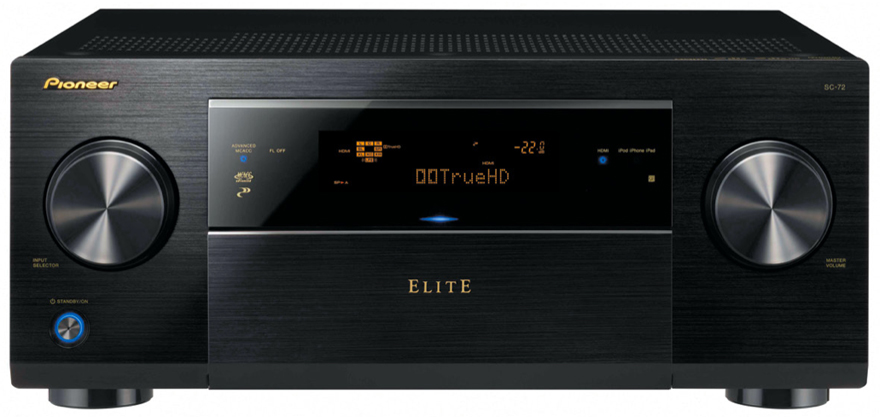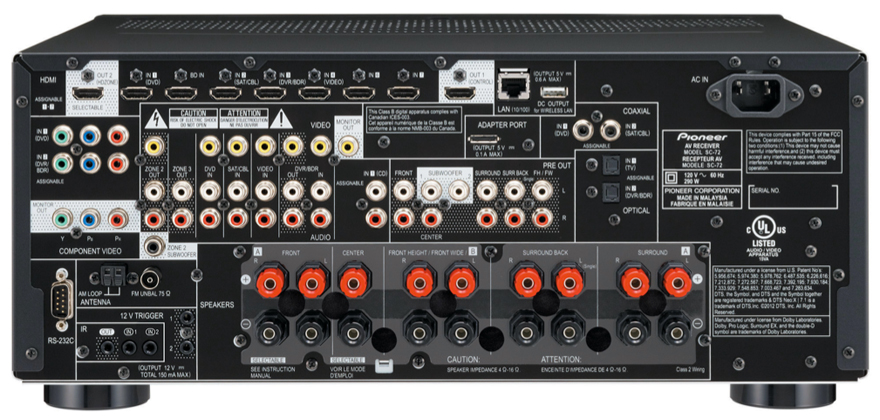Pioneer’s Elite category of home theater receivers have a reputation of being priced well above the usual consumer category. But the Pioneer SC-72 proves that Pioneer also wants to bring enthusiast features like custom installation to lower prices without sacrificing Pioneer’s signature audio technologies and networking features.
Design
The Pioneer Elite SC-72 is very much a carbon copy of the SC-1323-K both inside and out. Since it belongs in the Elite family of Pioneer receivers, the text on the display and Pioneer logo gets the golden treatment. The “Elite” logo is also proudly printed on the front panel which hides all the buttons and connection ports. Those familiar with the Pioneer models released in the past couple of years won’t see any surprises with this 2013 receiver but the build quality and overall sleekness can still hold its own. Because of the slightly higher wattage, the Pioneer SC-72 is slightly heavier than the SC-1323-K weighing at 31.88 lbs.
You will have to open the front panel door to access the front panel terminals. These ports include a phones jack, MCACC setup mic port, USB port with complementary video in and an MHL-enabled HDMI input. These ports should have you covered when it comes to connecting a modern portable device and you do not even have to use them given the strong networking support that the Elite SC-72 has. It is worth nothing that the MHL HDMI port and USB port have charging capabilities for smartphones and Apple devices.
On the back, the Pioneer SC-72 has the exact same layout as the SC-1323-K and unfortunately the connectors are not gold-plated like the SC-68. But it is easy to appreciate the 7 assignable HDMI inputs and 2 HDMI outputs opening up the possibility of connecting a multitude of components and devices as well an additional TV hooked up in another room. The 9.2-channel terminals are not color-coded but they are nicely separated and labeled so you shouldn’t get lost in hooking up the different speakers for your setup. The back also features 2 sets of component video inputs, 2 digital optical inputs, 2 digital coaxial inputs, a single audio in and 4 composite inputs along with the usual composite and component outputs. Custom installers may also utilize the RS-232C port, 12 V triggers and dual IR inputs and single output.
Below is the back panel layout. Click on image to enlarge for a clearer view.
Features
The Elite SC-72 harnesses Pioneer’s proprietary Class D3 amplification technology which Pioneer claims to be better than the receivers relying on Class AB amps. Class D3 amplification is superior in terms of audio performance in the sense that it can handle all 7 channels of 4 ohm speakers. Compared to the SC-1323-K, the wattage per channel is a little bit higher in the Pioneer SC-72 (130 watts versus 125 watts) but the overall sound quality should be similar. It is also capable of handling Dolby Pro Logic IIz, Dolby TrueHD, DTS Neo:X and DTS-HD Master Audio. This basically means that you can throw all of the latest Blu-ray content at the receiver and expect very good results. What is most surprising about Class D3 amplification is how it makes the Elite SC-72 operate at 90% efficiency. The remaining 10% is converted into heat which is far less than many competing receivers that can quickly get hot and potentially damage internal components and surrounding components in the AV rack. Combined with Pioneer’s sound enhancements like phase control and jitter reduction, the Pioneer SC-72 is a great candidate to consider on the audio front despite the lack of THX certification.
Older Pioneer Elite receivers in this price range aren’t exactly inferior when it comes to audio quality but the newer Elite SC-72 is ready to handle next generation technologies including 4K resolution. 4K pass-through is supported allowing 4K TVs to handle 4K content driven by the other next generation components supporting 4K. In addition to that, this receiver can also upscale lower resolution content to 4K resolutions so you can still enjoy high quality visuals if a 4K displays is connected to the receiver. Advanced Qdeo Video Processing is responsible for the picture enhancements.
The strong specs of the Pioneer SC-72 is backed up by a very friendly onscreen graphical user interface. It should be pretty easy for enthusiasts to figure out how to configure the receiver. Newbies, on the other hand can use the AVNavigator app which can be installed to a PC, Mac or iPad. This software relies on network connectivity so you have to connect the Elite SC-72 to the local network using the Ethernet cable or optional wireless LAN accessory (AS-WL300). Once the connection is established, you can use AVNavigator as a setup assistant to go through the necessary steps in connecting all your components and speakers and calibrating them so they sound their best. The Advanced MCACC Room Calibration isn’t exactly new but it continues to deliver good calibration results as it provides automatic crossover detection, polarity check and 3D time axis measurement.
Keeping the Pioneer SC-72 connected to the network also lets you enjoy the receiver’s rich networking features. With AirPlay and HTC Connect support out of the box, you can take your iOS device or recent HTC device and connect directly to the Elite SC-72 wirelessly so you can stream music with ease without any special app. The Pioneer SC-72 is also DLNA 1.5 certified allowing Windows 7 and Windows 8 systems to stream music too. Online support is a bit limited though with support for Pandora Internet Radio and vTuner. iOS and Android devices can use the freely available iControlAV2013 app to control the receiver remotely which can be useful if you will use Zone 2 and Zone 3 features.
Bottom Line
The Pioneer Elite SC-72 is priced at $1,300 making this Elite receiver an easy recommendation over the non-Elite and similarly priced SC-1323-K. Of course, you can still pick the SC-1323-K if the store is selling it for a discounted price and you won’t notice any lacking features. Compared to other home theater receivers, the Class D3 amplification adds a lot of value and it enables movie and music enthusiasts to really appreciate high quality audio at a lower price point.
Discontinued by Manufacturer


